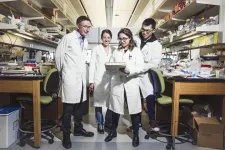(Press-News.org) Bottom Line: Among patients at high risk of melanoma, those who received routine skin cancer screening and education about skin self-exams were significantly more likely to be diagnosed with thinner and earlier stage melanomas.
Journal in Which the Study was Published: Cancer Epidemiology, Biomarkers & Prevention, a journal of the American Association for Cancer Research
Author: Michael Sargen, MD, a dermatologist and clinical fellow in the Division of Cancer Epidemiology and Genetics at the National Cancer Institute (NCI), part of the National Institutes of Health (NIH)
Background: "Whole-body screening for melanoma is currently routine for individuals at high risk for melanoma. These individuals include members of melanoma-prone families, categorized as having at least two relatives who have had melanoma, and those with inherited pathogenic gene variants that increase melanoma risk," said Sargen. "However, the benefit of screening in melanoma-prone families has not been previously quantified."
How the Study was Conducted: To better understand if screening and education among melanoma-prone families could result in earlier melanoma detection, Sargen and colleagues evaluated data from the NCI Familial Melanoma Study, which was initiated in 1976 to investigate inherited and environmental risk factors for the disease. "At enrollment and subsequent in-person visits to the NIH, study participants received whole-body screening for melanoma, total body photographs with closeups of potentially problematic moles, education about the appearance of melanoma, and strategies for protecting their skin from ultraviolet (UV) damage," Sargen explained. Participants in the study were also counseled to follow up with their local dermatologist annually for whole-body screening exams.
To evaluate the success of the study, Sargen and colleagues compared differences in melanoma thickness and tumor stage between participants diagnosed with melanoma before and after enrollment (the pre-study cohort and the prospective cohort, respectively). "Tumor thickness, or how deep the tumor grows beneath the surface of the skin, is associated with an increased risk of death from melanoma," said Sargen. The researchers also compared tumor thickness trends between participants in their study and cases in the general population by using data from Surveillance, Epidemiology, and End Results (SEER) registries.
Results: There was a total of 293 melanoma cases in the NCI Familial Melanoma Study, with 246 cases in the pre-study cohort, and 47 cases in the prospective cohort. Participants enrolled in the study from 1976 through 2014. There was a total of 79,530 cases analyzed in the SEER registries between 1973 to 2016. Because all of the participants in the NCI Familial Melanoma Study were white, analyses of SEER data were also restricted to white patients. Information on melanoma thickness was missing for 24 percent of melanoma cases in the NCI Familial Melanoma Study and 8.7 percent of melanoma cases found in the SEER registry; the researchers imputed the missing data.
Sargen and colleagues evaluated if the interventions in the NCI Familial Melanoma Study impacted melanoma thickness and tumor stage at diagnosis by comparing these features between the prospective and pre-study cohorts. After adjusting for gender and age, the researchers found that cases in the prospective cohort had significantly thinner melanomas compared with cases in the pre-study cohort (0.6mm versus 1.1mm, respectively). Further, cases in the prospective cohort were significantly more likely to be diagnosed at the early T1 stage compared with cases in the pre-study cohort (83 percent versus 40 percent, respectively).
Next, the researchers evaluated whether changes in melanoma thickness over time among cases in the NCI Familial Melanoma Study differed from trends observed in the general population. "Melanoma thickness at diagnosis in the United States has been decreasing since 1973, when we started tracking such data," Sargen explained. When the researchers compared the observed tumor thickness among members of melanoma-prone families with the expected tumor thickness based on the U.S. general population with respect to age, calendar period, and gender, they found that the melanomas diagnosed after enrollment in the NCI Familial Melanoma study were thinner than the predictions based on the U.S. general population.
Author's Comments: "This suggests that the downward trend in melanoma thickness observed in the general population does not fully explain the reductions in thickness seen in melanoma-prone families, and that long-term surveillance may assist in the earlier diagnosis of melanoma in high-risk populations," Sargen said.
"Our results suggest that the screening and education provided in the NCI Familial Melanoma Study may improve early detection of melanoma in melanoma-prone families," he added.
Study Limitations: Limitations of this study include the relatively small sample size of melanoma cases in the NCI Familial Melanoma Study and the imputation of missing melanoma thickness data. "Additionally, since this was a prospective cohort study, we were not able to distinguish the independent effect of each intervention," Sargen said. "Randomized control studies are needed to understand the impact of each aspect of the intervention, such as whole-body screening, melanoma education, or strategies for skin protection."
INFORMATION:
Funding & Disclosures: This study was sponsored by the Intramural Research Program of the Division of Cancer Epidemiology and Genetics at the NCI, part of the NIH. Sargen declares no conflicts of interest.
To interview Michael Sargen, please contact Richard Lobb at richard.lobb@aacr.org or 215-906-3322.
About the American Association for Cancer Research
Founded in 1907, the American Association for Cancer Research (AACR) is the world's first and largest professional organization dedicated to advancing cancer research and its mission to prevent and cure cancer. AACR membership includes 48,000 laboratory, translational, and clinical researchers; population scientists; other health care professionals; and patient advocates residing in 127 countries. The AACR marshals the full spectrum of expertise of the cancer community to accelerate progress in the prevention, diagnosis, and treatment of cancer by annually convening more than 30 conferences and educational workshops--the largest of which is the AACR Annual Meeting, with more than 74,000 attendees for the 2020 virtual meetings and more than 22,500 attendees for past in-person meetings. In addition, the AACR publishes nine prestigious, peer-reviewed scientific journals and a magazine for cancer survivors, patients, and their caregivers. The AACR funds meritorious research directly as well as in cooperation with numerous cancer organizations. As the Scientific Partner of Stand Up To Cancer, the AACR provides expert peer review, grants administration, and scientific oversight of team science and individual investigator grants in cancer research that have the potential for near-term patient benefit. The AACR actively communicates with legislators and other policymakers about the value of cancer research and related biomedical science in saving lives from cancer. For more information about the AACR, visit http://www.AACR.org.
The Tibet ASγ experiment, a China-Japan joint research project on cosmic-ray observation, has discovered ultra-high-energy diffuse gamma rays from the Milky Way galaxy. The highest energy detected is estimated to be unprecedentedly high, nearly 1 Peta electronvolts (PeV, or one million billion eV).
Surprisingly, these gamma rays do not point back to known high-energy gamma-ray sources, but are spread out across the Milky Way (see Fig.1).
Scientists believe these gamma rays are produced by the nuclear interaction between cosmic rays escaping from the most powerful galactic sources ...
A dangerous toxin has been witnessed - for the first time - releasing into the air from pond scum, research published in the peer-reviewed journal Lake and Reservoir Management today shows.
Not only is pond scum - otherwise known as algal bloom - an unsightly formation which can occur on still water across the world, it can also prove dangerous to wildlife and humans.
For the first time, scientists have now detected the presence of the algal toxin anatoxin-a (ATX)which is also known as 'Very Fast Death Factor', in the air near a Massachusetts pond with large algal blooms.
ATX can cause a range of symptoms at acute doses, including loss of coordination, muscular twitching and respiratory paralysis, and has been linked to the deaths of livestock, waterfowl and dogs from ...
Researchers from University of Queensland, University of Melbourne, and Universidad Finis Terrae published a new paper in the Journal of Marketing that studies consumer resistance to a nationwide plastic bag ban implemented in Chile in 2019.
The study, forthcoming in the Journal of Marketing, is titled "How Do I Carry All This Now?': Understanding Consumer Resistance to Sustainability Interventions" and is authored by Claudia Gonzalez-Arcos, Alison M. Joubert, Daiane Scaraboto, and Jörgen Sandberg.
As environmental crisis challenges accelerate, governments are searching for solutions to reduce the negative impacts of economic activity. One popular measure has been to ban disposable plastic ...
A palliative care doctor has suggested that studying Shakespeare's plays could help medical students connect more closely with their patients. Writing in the Journal of the Royal Society of Medicine Dr David Jeffrey, of the Department of Palliative Medicine at the University of Edinburgh, investigates how the playwright's empathic approach - the ability to understand and share the feelings of another - can enhance the patient-doctor relationship.
Dr Jeffrey writes that the idea that emotions are disruptive and need to be controlled is deeply ingrained in medical education and practice, contributing to doctors distancing from patients. The coronavirus pandemic, with ...
Fewer than half of inmates in jails and prisons surveyed in a study by the CDC and University of Washington said they would accept a COVID-19 vaccine, while the majority either said they wanted to wait before getting the vaccine or would refuse one.
"This is a population already at risk for COVID-19, and outbreaks among incarcerated people can worsen inequities in COVID-19 outcomes as well as contribute to spread in the surrounding community," said lead author Dr. Marc Stern, affiliate assistant professor of health services in the UW School of Public Health. "So culturally and health-literacy informed interventions are needed to help them feel more confident about getting vaccinated."
The study conducted by CDC researchers ...
As the COVID-19 pandemic lingers, researchers have found associations between certain lifestyle factors and a person's risk of getting infected. While it has already been established that those with Type II diabetes and a high body mass index (BMI) are at greater risk of experiencing hospitalizations and other severe complications related to COVID-19, they are also at greater risk of getting symptomatic infection in the first place. That is the finding of a recent study conducted by researchers at the University of Maryland School of Medicine that was published today in the journal PLoS ONE.
Using data from the UK Biobank of 500,000 British volunteers over age 40, the researchers examined ...
ROCHESTER, Minn. -- All too often, patients with high levels of antibodies face major challenges getting a transplant. These highly sensitized patients have a much higher risk of death while waiting for suitable organs they are less likely to reject. But there is new hope for highly sensitized patients in need of a combined heart and liver transplant, thanks to an innovative surgical approach at Mayo Clinic.
Traditionally, surgeons transplant the heart first, followed by the liver. But Mayo Clinic heart transplant team decided to reverse the order for highly sensitized patients in the hopes that the liver would absorb some of the patient's antibodies, removing them from circulation and lowering ...
Researchers have confirmed for the first time that Pine Island Glacier in West Antarctica could cross tipping points, leading to a rapid and irreversible retreat which would have significant consequences for global sea level.
Pine Island Glacier is a region of fast-flowing ice draining an area of West Antarctica approximately two thirds the size of the UK. The glacier is a particular cause for concern as it is losing more ice than any other glacier in Antarctica.
Currently, Pine Island Glacier together with its neighbouring Thwaites glacier are responsible for about 10% of the ongoing increase in global sea level.
Scientists have argued for some time that this region of Antarctica could reach a tipping point and undergo an irreversible ...
Kidney development is a balancing act between the self-renewal of stem and progenitor cells to maintain and expand their numbers, and the differentiation of these cells into more specialized cell types. In a new study in the journal eLife from Andy McMahon's laboratory in the Department of Stem Cell Biology and Regenerative Medicine at the Keck School of Medicine of USC, former graduate student Alex Quiyu Guo and a team of scientists demonstrate the importance of a molecule called β-catenin in striking this balance.
β-catenin is a key driver at the end of a complex signaling cascade known as the Wnt pathway. Wnt signaling plays critical roles in the embryonic development of multiple organs including the kidneys. By partnering with ...
Key Takeaways:
Discounting or couponing is not the most effective way to tap the power of retargeting in online marketing.
Customized seller recommendations may be more powerful than discounting.
Seller auctions that allow marketers to self-select in the retargeting process improve cost efficiency.
CATONSVILLE, MD, April 1, 2021 - Online marketers have seen the pattern: 95%-98% of online visitors search for something, but the search never converts into a purchase and they leave the site without buying. For marketers, this results in speculation and assumptions that can lead to wasted time and investments in ineffective marketing programs.
One of the more common ways online marketers attempt to solve this problem is to "retarget," which tracks those consumers and reconnects ...


